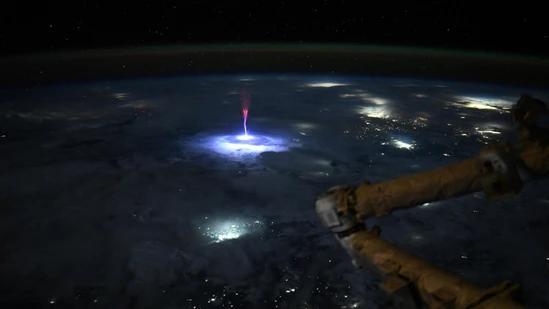
NASA Astronaut Captures Rare ‘Sprite’ Lightning Over US & Mexico
In a remarkable feat, NASA astronaut Nichole Ayers has captured a rare and breathtaking phenomenon known as ‘sprite’ lightning while orbiting above the United States and Mexico. The stunning image, taken from the International Space Station, has left scientists and enthusiasts alike in awe.
Ayers, a seasoned astronaut with multiple missions under her belt, shared the picture on social media, revealing a vibrant display of transient luminous events (TLEs) in the atmosphere. The sprite, a type of TLE, is a brief burst of light that occurs above thunderstorms, making it a rare and elusive sighting.
The phenomenon is so rare that it’s often referred to as “fair weather lightning” since it occurs outside of traditional thunderstorm conditions. According to NASA, sprites are typically 25 to 100 kilometers (15 to 62 miles) tall and can be thousands of kilometers long. They are characterized by their bright, glowing trails and emit a reddish-orange color due to the presence of excited oxygen and nitrogen atoms.
Ayers’ incredible capture is a testament to the vastness and complexity of our atmosphere. “Scientists can use these types of photos to better understand the relationship of TLEs to thunderstorms,” she said in a statement. Her image has sparked widespread interest and excitement among scientists, researchers, and space enthusiasts, offering a unique glimpse into the workings of our planet’s atmosphere.
The International Space Station, where Ayers was stationed, provides a unique vantage point for capturing rare atmospheric phenomena like sprites. With its orbit above the Earth, astronauts on board the ISS can observe and document events that may not be visible from the ground. This unique perspective has led to numerous groundbreaking discoveries and a deeper understanding of the Earth’s atmosphere.
Sprites are not the only type of TLE; there are several others, including elves, blue jets, and gigantic jets. Each type of TLE has its own unique characteristics and formation mechanisms, making them fascinating subjects for study and research.
NASA and other scientific organizations have dedicated significant resources to studying TLEs, as they can provide valuable insights into the Earth’s atmosphere and the complex interactions between the atmosphere, lightning, and the ionosphere. By analyzing data and images like Ayers’, scientists can better understand the processes that govern these phenomena, ultimately leading to improved forecasting and a deeper appreciation for the dynamic nature of our planet.
Ayers’ remarkable capture has sparked renewed interest in the study of TLEs, with many scientists and enthusiasts eager to learn more about this rare and captivating phenomenon. As we continue to explore and study the Earth’s atmosphere, we may uncover new and exciting discoveries, like Ayers’ sprite, that shed light on the intricate workings of our planet.
News Source:






